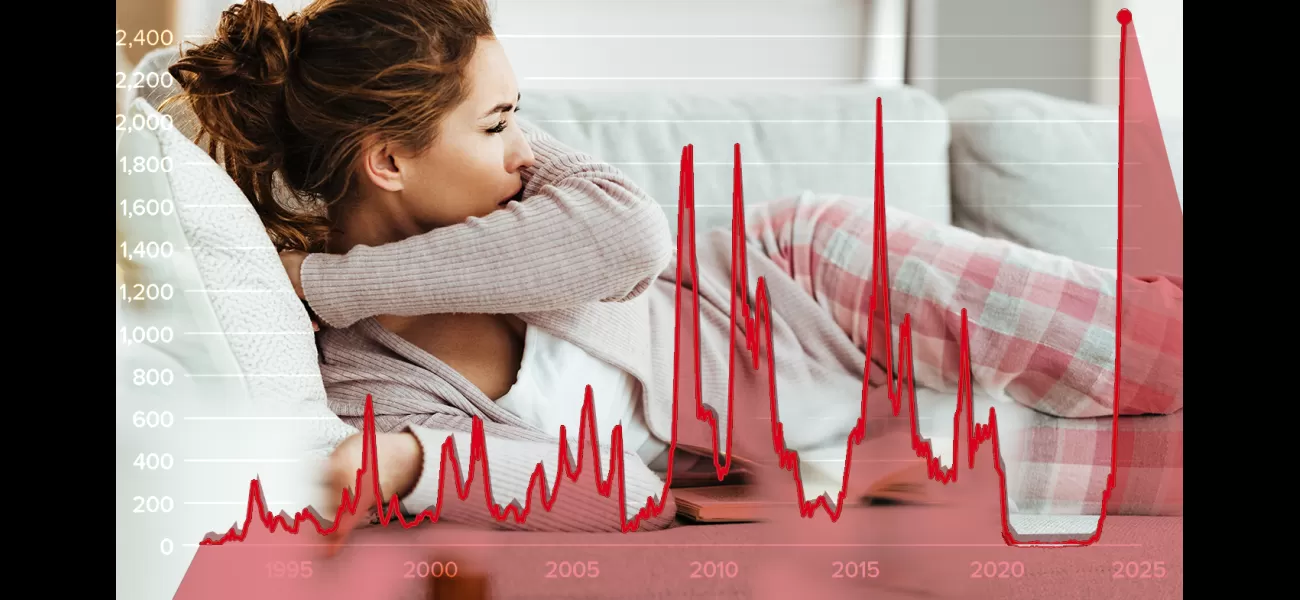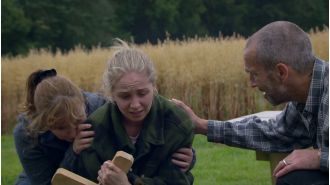Health professionals warn of record levels of whooping cough in a single state.
Whooping cough cases this year are approaching levels seen during the last epidemic in 2012.
August 13th 2024.

Australian health authorities are urging citizens to prioritize getting vaccinated against whooping cough as the disease continues to spread across the country. The number of cases in one state has reached a record high, which is the highest it has been in over thirty years of recorded data.
The situation is further complicated by the presence of multiple respiratory illnesses, including COVID-19, influenza, RSV, and mycoplasma pneumoniae, all circulating at higher levels than usual. In July alone, there were 2490 reported cases of whooping cough in New South Wales, making it the highest number of cases in a single month since records began in 1991.
To put this into perspective, the number of cases in just one month is higher than the total number of cases reported in the entire country in 2023. So far this year, there have been over 19,300 cases across Australia, which is already comparable to the last epidemic year of 2016, where there were 20,117 cases. And there are still five months left in the year, which means the number of cases could potentially surpass the previous outbreak.
Queensland was the first state to experience a sharp increase in cases late last year, followed closely by New South Wales. Now, other states like South Australia and Western Australia are also reporting an alarming rise in cases, surpassing levels seen before the pandemic. Health authorities warn that the outbreak is far from over and could continue for several more months.
But what is causing such a severe outbreak, and what can be done about it? To understand this, we must first understand what whooping cough is and how it spreads.
Whooping cough, also known as pertussis, is a bacterial infection that starts with symptoms similar to the common flu, such as fever, cough, and fatigue. However, it can progress into severe bouts of coughing, which can be so intense that they can cause broken bones in the elderly. It is highly contagious, and a person can remain contagious for three weeks or until they complete a course of antibiotics.
The disease can be life-threatening for young babies, especially those who have not yet been vaccinated against it. This is why it is crucial for pregnant women to get vaccinated, as it can provide protection for their newborn babies. However, it is estimated that about a third of pregnant mothers do not receive the vaccination.
The disruption caused by the COVID-19 pandemic is likely to blame for the current outbreak. The restrictions and school shutdowns not only caused a decrease in the uptake of the whooping cough vaccine but also virtually eliminated the spread of the disease. Typically, whooping cough outbreaks occur every three to five years, but due to the pandemic, there have been no reported cases in 2020 and 2021. This means that it has been eight years since the last significant outbreak, and when it did resurface, it was bound to be more severe.
Experts also believe that the lack of exposure to these types of diseases in the community has contributed to the current situation. This has led to an "immunity debt," not just for whooping cough but also for other respiratory illnesses like influenza and RSV. This explains why we are currently seeing a convergence of multiple respiratory illnesses across the country.
But just how serious is whooping cough? Also known as the "100-day cough," it can be a troublesome illness for anyone, with prolonged and severe coughing episodes lasting for weeks. However, it is most severe in older people and young children, especially babies who have not yet received multiple vaccinations.
Before the introduction of the vaccination for pregnant women in 2018, an average of one baby under six months would die, and more than 200 would be hospitalized each year in Australia. While the new vaccination has reduced these numbers, it is estimated that about a third of pregnant women still do not receive it.
To protect your family, the most important thing is to ensure that everyone is fully immunized. This includes receiving six pertussis doses during childhood, followed by a booster dose in high school. Pregnant women, healthcare workers, and childcare workers are also recommended to get vaccinated. Additionally, anyone who has not been vaccinated in the last five to ten years could benefit from a booster.
Lastly, how can we tell if a cough is due to whooping cough? It can be challenging to distinguish it from other respiratory illnesses, especially during this time when there is an increase in all types of respiratory infections. The "classic" manifestation of whooping cough is a severe, staccato-like cough that comes in bouts, followed by a whooping sound as the person tries to take a breath. However, this distinctive cough usually does not appear until several days into the illness. So, the best way to confirm if it is whooping cough is to get tested, especially for young children.
In conclusion, health authorities are urging Australians to prioritize getting vaccinated against whooping cough to protect themselves and their families. The current outbreak can be attributed to the disruption caused by the COVID-19 pandemic, which has led to a lack of immunity in the community. It is vital to understand the severity of whooping cough and take necessary precautions to prevent its spread.
The situation is further complicated by the presence of multiple respiratory illnesses, including COVID-19, influenza, RSV, and mycoplasma pneumoniae, all circulating at higher levels than usual. In July alone, there were 2490 reported cases of whooping cough in New South Wales, making it the highest number of cases in a single month since records began in 1991.
To put this into perspective, the number of cases in just one month is higher than the total number of cases reported in the entire country in 2023. So far this year, there have been over 19,300 cases across Australia, which is already comparable to the last epidemic year of 2016, where there were 20,117 cases. And there are still five months left in the year, which means the number of cases could potentially surpass the previous outbreak.
Queensland was the first state to experience a sharp increase in cases late last year, followed closely by New South Wales. Now, other states like South Australia and Western Australia are also reporting an alarming rise in cases, surpassing levels seen before the pandemic. Health authorities warn that the outbreak is far from over and could continue for several more months.
But what is causing such a severe outbreak, and what can be done about it? To understand this, we must first understand what whooping cough is and how it spreads.
Whooping cough, also known as pertussis, is a bacterial infection that starts with symptoms similar to the common flu, such as fever, cough, and fatigue. However, it can progress into severe bouts of coughing, which can be so intense that they can cause broken bones in the elderly. It is highly contagious, and a person can remain contagious for three weeks or until they complete a course of antibiotics.
The disease can be life-threatening for young babies, especially those who have not yet been vaccinated against it. This is why it is crucial for pregnant women to get vaccinated, as it can provide protection for their newborn babies. However, it is estimated that about a third of pregnant mothers do not receive the vaccination.
The disruption caused by the COVID-19 pandemic is likely to blame for the current outbreak. The restrictions and school shutdowns not only caused a decrease in the uptake of the whooping cough vaccine but also virtually eliminated the spread of the disease. Typically, whooping cough outbreaks occur every three to five years, but due to the pandemic, there have been no reported cases in 2020 and 2021. This means that it has been eight years since the last significant outbreak, and when it did resurface, it was bound to be more severe.
Experts also believe that the lack of exposure to these types of diseases in the community has contributed to the current situation. This has led to an "immunity debt," not just for whooping cough but also for other respiratory illnesses like influenza and RSV. This explains why we are currently seeing a convergence of multiple respiratory illnesses across the country.
But just how serious is whooping cough? Also known as the "100-day cough," it can be a troublesome illness for anyone, with prolonged and severe coughing episodes lasting for weeks. However, it is most severe in older people and young children, especially babies who have not yet received multiple vaccinations.
Before the introduction of the vaccination for pregnant women in 2018, an average of one baby under six months would die, and more than 200 would be hospitalized each year in Australia. While the new vaccination has reduced these numbers, it is estimated that about a third of pregnant women still do not receive it.
To protect your family, the most important thing is to ensure that everyone is fully immunized. This includes receiving six pertussis doses during childhood, followed by a booster dose in high school. Pregnant women, healthcare workers, and childcare workers are also recommended to get vaccinated. Additionally, anyone who has not been vaccinated in the last five to ten years could benefit from a booster.
Lastly, how can we tell if a cough is due to whooping cough? It can be challenging to distinguish it from other respiratory illnesses, especially during this time when there is an increase in all types of respiratory infections. The "classic" manifestation of whooping cough is a severe, staccato-like cough that comes in bouts, followed by a whooping sound as the person tries to take a breath. However, this distinctive cough usually does not appear until several days into the illness. So, the best way to confirm if it is whooping cough is to get tested, especially for young children.
In conclusion, health authorities are urging Australians to prioritize getting vaccinated against whooping cough to protect themselves and their families. The current outbreak can be attributed to the disruption caused by the COVID-19 pandemic, which has led to a lack of immunity in the community. It is vital to understand the severity of whooping cough and take necessary precautions to prevent its spread.
[This article has been trending online recently and has been generated with AI. Your feed is customized.]
[Generative AI is experimental.]
0
0
Submit Comment





